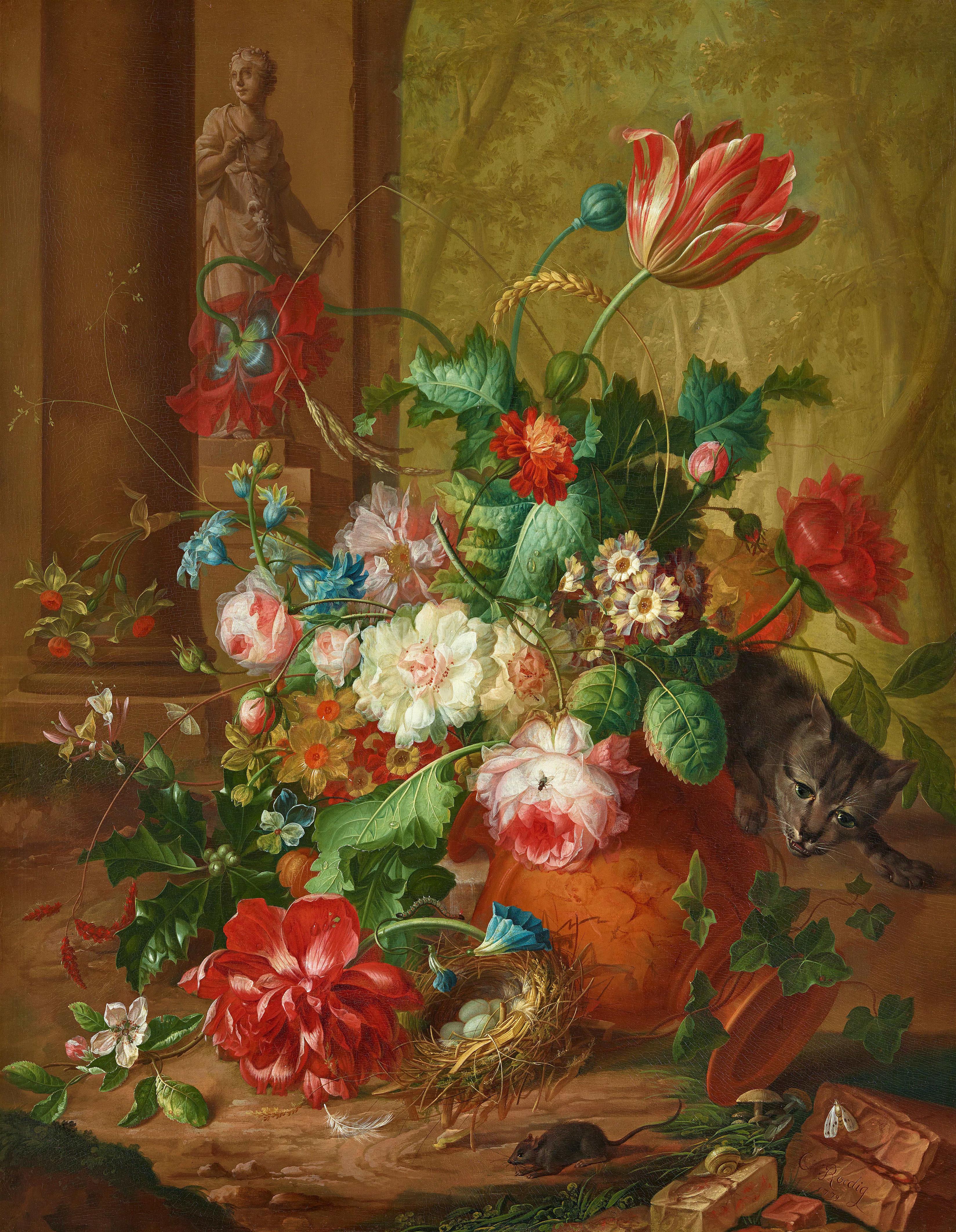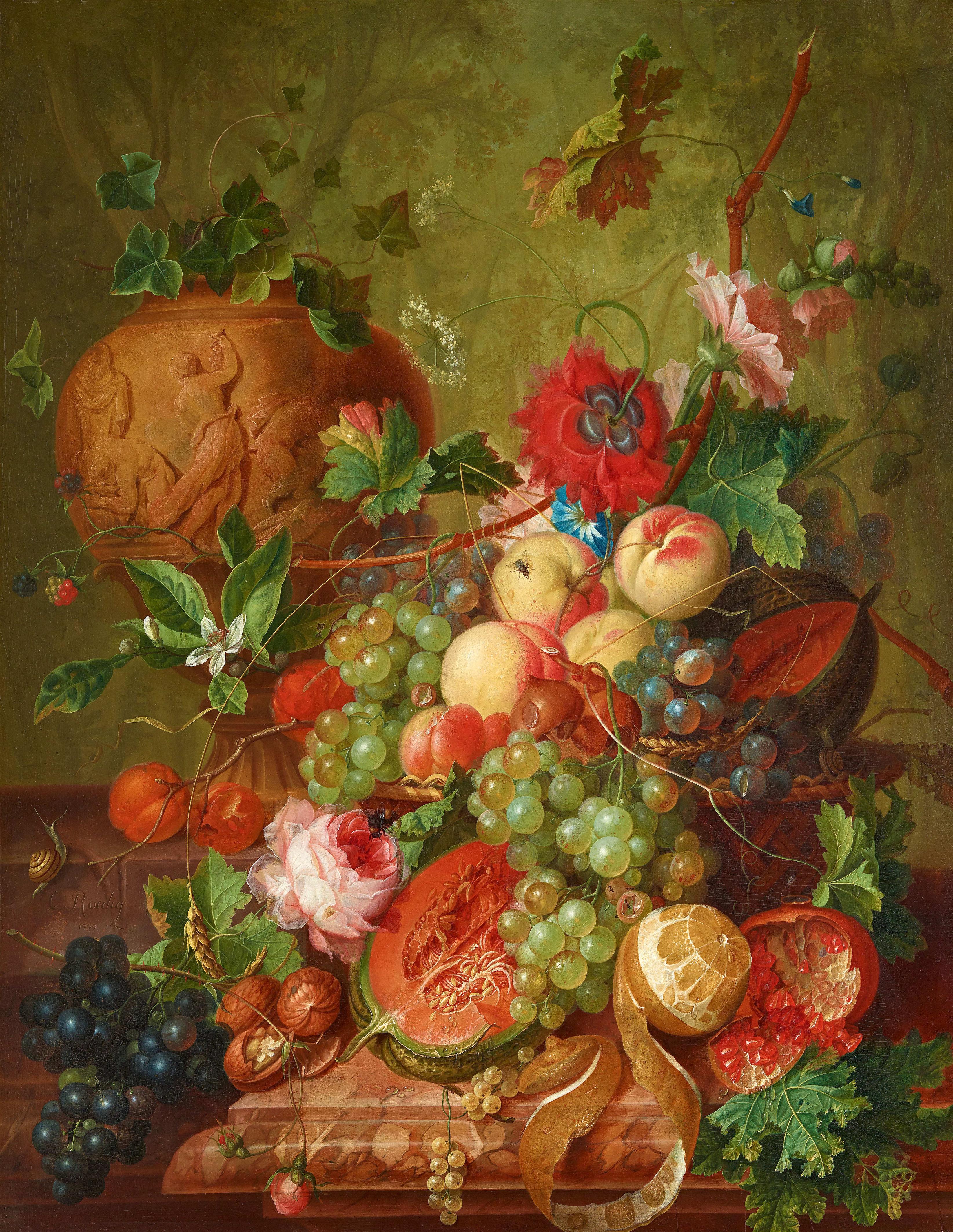Johannes Christianus Roedig
Still Life of Flowers with Stone Sculpture, Cat and Mouse
Fruit Still Life with Ceramic Vase
Oil on panel. 72.4 x 57.9 cm and 73.3 x 58.1 cm.
Signed and dated lower right: C. Roedig 1779, and lower left: C. Roedig 1779.
When Tsar Nicholas I was looking for a special Christmas present for his sister-in-law, Princess Alexandrine of Prussia, in 1852, he ordered two large paintings on porcelain from the Imperial Porcelain Manufactory in St. Petersburg. These reproduced two masterpieces, floral still lifes, from the Hermitage collection - one by Jan van Huysum, the other by Johannes Christianus Roedig. Apparently, 50 years after Roedig's death, the appreciation of his painting was still very much alive at the Tsar's court.
The Dutch artist's works had entered the Hermitage collection under Tsarina Catherine II in the previous century. What Catherine II and other princely collectors of the 18th century admired in Roedig's flower and fruit still lifes can be seen in this pair of paintings of extraordinary splendour and quality, which can be counted among Roedig's major works. It is a fortunate coincidence that the two paintings have remained together since their creation; their provenance can be traced back to the first owner in The Hague, the artist's home town.
The pair of paintings, a flower still life and a fruit still life, are a tour de force of Roedig's skill as a still life painter, which is evident in the opulence of the composition, the delicacy of the painting and the brilliance of the colour palette. The floral still life is set in a palace garden decorated with figures and reflects the refined aristocratic taste of the late 18th century. The viewer is presented with a multitude of flowers, the depiction revels in the shapes, colours, patterns and textures of the various petals, which are magnificently staged in the bright light. On closer inspection, one realises that the vase has been toppled, probably pushed over by the cat in its pursuit of a mouse.
Withered petals remind the viewer of the transience of all earthly things, but the vanitas aspect does not cloud the cheerful, colourful mood, which is also reflected in the statue of Flora, the goddess of spring, in the background. The fruit still life, on the other hand, represents the season of autumn; this is illustrated by the fact that the vessel is adorned with a bacchanalian scene. While the flower still life impresses us with the delicate shapes and colours of the flowers, the powerful colour contrasts dominate here: the yellow of the lemon, the red of the pomegranate, the green of the grapes. The sliced pumpkin, the split pomegranate and the peeled lemon present the viewer with a variety of shapes as well as flavours; the opulent arrangement in the basket, laid out on a precious marble table, spreads out the fruits of a rich autumnal harvest before the viewer's gaze.
Johannes Christianus Roedig was one of the last great representatives of a long tradition of Dutch flower and fruit still lifes that lasted almost 200 years. Roedig's best works went to foreign courts, but this pair of paintings remained in The Hague with Pieter Lyonet, a Dutch naturalist. In the catalogue of his estate auction, the two still lifes appear as lots 217 and 218 - it is fortunate that they went to the same bidder at the time and have remained together to this day; together they still form a magnificent, colourful feast for the eyes.
Provenance
Sale, Pieter Lyonet, Amsterdam (Bunel and Yver), 11.4.1791, lot 217 and 218. - Sale, Amsterdam (Van der Schley .. Vinkeles), 7.5.1804, lot 145. -
Sale, Wreesman, Amsterdam (Van der Schley .. Vries), 11.4.1816, lot 154. - Private Collection, the Netherlands, circa 1820 and thence by descent until ca. 1970. -
Collection of Miss Wurfbain, Wassenaar, 1983. - With Hoogsteder & Hoogsteder, 1987. - Dutch private collection. - Bonham's, London, 9.12.2009, lot 81 (1,196,000 GBP). - Dutch private collection.
Literature
S. Segal: Boeket in Willet : Nederlandse bloemstillevens in de achttiende en de eerste helft van de negentiende eeuw, Amsterdam, ex. cat. Museum Willet-Holthuysen, Amsterdam 1970, Nr. 26, m. Abb. - S. Segal: A Fruitful Past : A Survey of the Fruit Still Lifes of the Northern and Southern Netherlands from Brueghel till Van Gogh, ex. cat. Herzog Anton Ulrich-Museum / P. de Boer, Amsterdam 1983, pp. 86-87, no. 70-71, ill.
Exhibitions
Nederlandse bloemstillevens in de achttiende en de eerste helft van de negentiende eeuw, Museum Boeket in Willet, Amsterdam, 1970, no. 26 (nur das Blumenstillleben). - A Survey of the Fruit Still Lifes of the Northern and Southern Netherlands from Brueghel till Van Gogh, P. de Boer, Amsterdam / Herzog Anton Ulrich-Museum, Brunswick, 1983, no. 70-71




